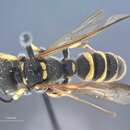Comprehensive Description
(
англиски
)
добавил Smithsonian Contributions to Zoology
Cerceris flavotrochanterica Rohwer, 1912:471
MALE.—Length 12 mm. Black with light yellow markings; punctation and pubescence average.
Head subequal in width to the thorax, black except the entire face below the antennal scrobes, a minute evanescent spot back of the eye (lacking on many specimens), and a patch on the basal half of mandibles, all of which are light yellow; clypeal border with three distinct denticles; hair lobes extending over approximately two-thirds of the lateral clypeal lobe; mandibles without denticles but showing two slight elevations on the upper carina; antennae normal in form.
Thorax black except for a divided band on the pronotum, two lateral patches on the scutellum, and most of the tegulae, all of which are light yellow; tegulae normal; enclosure heavily ridged subparallel to the medial groove, which is prominent; mesosternal tubercle absent; fore- and midlegs black to dark fuscous to distal ends of femori, hind trochanters light yellow, hind femori black basally, becoming amber distally (amber area variable in extent), fore-and midtibiae largely yellow, hind tibiae largely dark distally, fore- and midtarsi largely yellow; hind tarsi dark; wings subhyaline but darker along the anterior area.
Abdomen black except for subequal bands on terga 2, 3, 4, 5, and 6, all of which become much broader laterally; lateral patches on sterna 2, 3, 4, and 5, those on sterna 3 and 4 much larger; pygidium as illustrated (Figure 154b).
FEMALE.—Unknown. This quite distinctive male can well be the male of one of the several females described for which the male is unknown.
TYPE.—The type male of Cerceris flavotrochanterica Rohwer, taken from the Federal District of Mexico (Prof. G. Gandara), is at the National Museum of Natural History (USNM 14179).
DISTRIBUTION.—Later collection of this species determined by the present author have come from higher altitudes of central and southern Mexico. Specimens are as follows:
MEXICO: DURANGO: 12♂, 20 mi W Durango, 7100 ft, 17 June 1964 (DB); ♂, Encino, 6200 ft, 27 July 1947 (RME). DISTRITO FEDERAL: ♂, Chapingo, August 1924; ♂, Federal District (GG); ♂, same locality (LCo). MEXICO: ♂, Teotihuacan, 16 June 1597 (HEw); 3♂, same locality, 15 June, 6 July 1951 (PDH). VERACRUZ: ♂, Orizaba, 12–22 August 1961 (R and KD).
PREY RECORD.—None.
PLANT RECORD.—None.
- библиографски навод
- Scullen, Herman Austin. 1972. "Review of the genus Cerceris Latreille in Mexico and Central America (Hymenoptera: Sphecidae)." Smithsonian Contributions to Zoology. 1-121. https://doi.org/10.5479/si.00810282.110
Comprehensive Description
(
англиски
)
добавил Smithsonian Contributions to Zoology
Cerceris duisi
FEMALE.—Length 11 mm. Black with yellow markings; punctation and pubescence average.
Head subequal in width to the thorax; black except for large frontal eye patches, a small spot on the frons, the clypeal process, spot back of eye, and the basal half of mandibles, all of which are yellow; clypeal free margin with five denticles, the medial one somewhat smaller than the others and more rounded; clypeal process subequal to one-half the distance between the compound eyes, the surface yellow, and the free margin with two semioval lamella, which are fused at their base; mandibles with two subequal denticles; antennae normal in form, immaculate, and uniformly dark.
Thorax black except for a widely divided band on the pronotum, a divided wide band on the scutellum, and a patch on the tegulae, all of which are yellow; tegulae normally smooth; enclosure lightly ridged; mesopleural tubercle small but distinct; legs black to the distal ends of all femori, which are amber, and the hind trochanters, which are yellow; tibiae and tarsi yellow infringed with amber; wings subhyaline but clouded along the anterior borders of the fore wings.
Abdomen black except for a broad patch on terum 1, broad but deeply emarginate bands on terga 2, 3, 4, and 5, and lateral patches on sterna 3 and 4, all of which are yellow; pygidium as illustrated (Figure 126c).
MALE.—Unknown.
TYPES.—The holotype female of Cerceris duisi Scullen, which was taken 10 miles southwest of Mendoza, Veracruz, Mexico, at 5300 feet elevation, 25 August 1963, by H. A. Scullen and Duis Bolinger, is at the National Museum of Natural History (USNM 71064). Paratypes are as follows:
MEXICO: CHIHUAHUA: ♀, 8 mi W of Matachic, 7200 ft, 8 July 1947 (CDM). DISTRITO FEDERAL: ♀, Atzcapotzalco, 5–31 July 1921. DURANGO: ♀, 10 mi W Durango, 12 July 1954 (EIS). JALISCO: ♀, 20 mi S Guadalajara, 19 July 1963 (S and B). MEXICO: ♀, Teoihuacan, 6 July 1951 (HEE); 9, same locality and date (PDH). VERACRUZ: 4♀, 10 mi SW Mendoza, 5300 ft, 25 August 1963 (S and B); 3♀, Orizaba, 12 August 1961 (R and KD). STATE UNKNOWN: ♀, Atzcapico, 31 August 1922 (EGS).
DISTRIBUTION.—Scattered records but apparently more common in state of Veracruz.
PREY RECORD.—None.
PLANT RECORD.—None.
- библиографски навод
- Scullen, Herman Austin. 1972. "Review of the genus Cerceris Latreille in Mexico and Central America (Hymenoptera: Sphecidae)." Smithsonian Contributions to Zoology. 1-121. https://doi.org/10.5479/si.00810282.110

